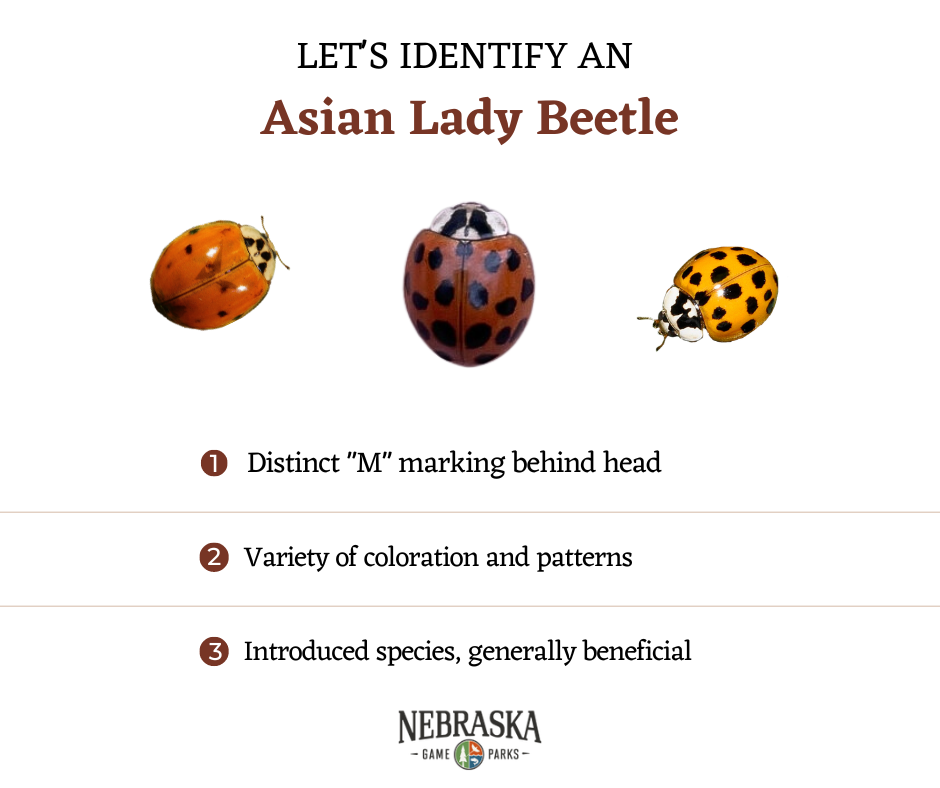
By Alie Mayes, Community Science Specialist
Lady beetles, also known as ladybird beetles or ladybugs, are common and widely recognized insects. They are marketed in popular culture as charismatic and “cute,” featured on a variety of children’s clothing, toys and even TV shows. But what do we really know about lady beetles in Nebraska?
Life History
Lady beetles belong to the beetle family Coccinellidae. They are commonly thought of as red with back spots, though different species have varying colors. These are relatively small beetles, most measuring under 10 mm in length. Most species are predators, eating aphids and other soft-bodied insects. Because they prey on common garden pests, lady beetles are regarded as beneficial insects.
Lady beetles undergo complete metamorphosis, passing through four developmental stages of egg, larva, pupa and adult. Maybe one of the most surprising things about lady beetles is how drastically different they look as larva compared to their adult form. If you didn’t know better, you may mistake their larval stage for a separate species altogether.
Nebraska lady beetles overwinter as adults in large groups under logs and leaf litter. They emit a pheromone that attracts others to them, forming aggregates of hundreds or even thousands of individuals!
Nebraska Lady Beetles
There is much to learn about the lady beetles that live in Nebraska. According to Dr. Matt Brust of Chadron State College, there are likely over 40 species that call Nebraska home. About half of this number are what we consider “micro” lady beetles. These beetles are small, usually under 2.5 mm in length. They are often brown to black in color and difficult to identify.
There are, however, around 20 “macro” lady beetles in Nebraska. These beetles are around 3- 11 mm in length and vary in color combinations of yellow, orange, red, black and white. These larger, more colorful lady beetles are generally easier to identify.
Tracking Lady Beetles – We Need Your Help!
While some lady beetles are common in Nebraska, other species, such as the prolongate lady beetles (Coccinella prolongata), have only been recorded three times in the state. All three records hail from within Sioux County. In order to better understand what lady beetles are in the state, the Nebraska Game and Parks Commission has set up a project on iNaturalist called Lady Beetles of Nebraska.
So far, this project has captured 820 lady beetle observations of around 25 different species. The most common and least prioritized observations are that of the multicolored Asian lady beetle (Harmonia axyridis). This introduced lady beetle thrives in Nebraska and can be considered a pest species because of its tendency to overwinter in large groups in the cracks and crevices of people’s homes. The best way to identify the Asian lady beetle is by looking for the “M” marking behind the beetle’s head.
Next time you are in your garden or local green space, remember to look for lady beetles! For this project, we are asking the public to submit photos of lady beetles found in Nebraska. To aid with identification, please submit 3 photos with the following angles:
- Top down – the camera pointing above the lady beetle.
- Side view
- Front view- the camera focused on the head of the beetle.
Your contributions will help us learn more about these beneficial insects!

